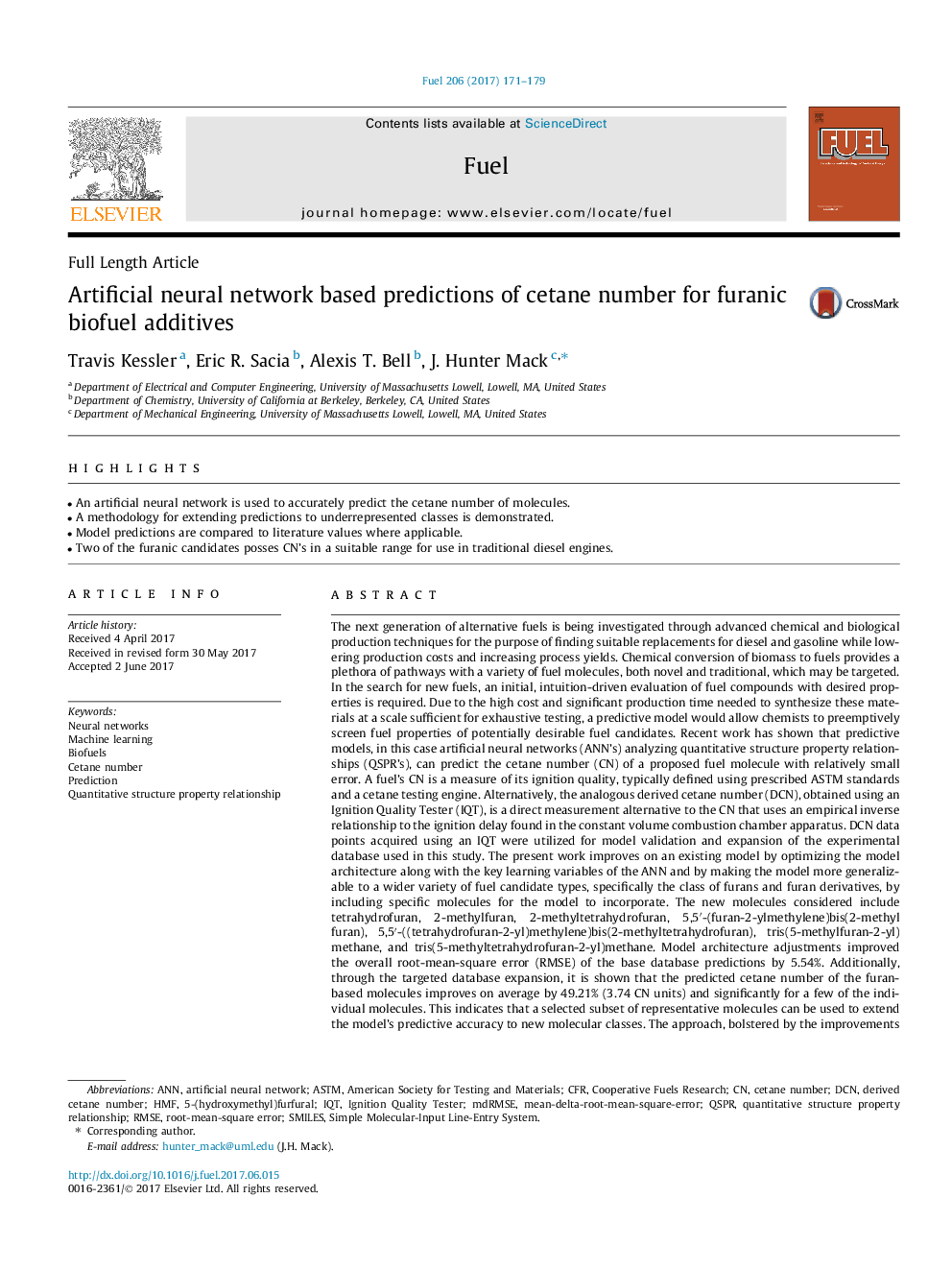| کد مقاله | کد نشریه | سال انتشار | مقاله انگلیسی | نسخه تمام متن |
|---|---|---|---|---|
| 4768562 | 1424958 | 2017 | 9 صفحه PDF | دانلود رایگان |
عنوان انگلیسی مقاله ISI
Artificial neural network based predictions of cetane number for furanic biofuel additives
ترجمه فارسی عنوان
پیش بینی های شبکه عصبی مصنوعی از تعداد سیتان برای افزودنی های سوخت زیستی فوران
دانلود مقاله + سفارش ترجمه
دانلود مقاله ISI انگلیسی
رایگان برای ایرانیان
کلمات کلیدی
SMILESANNDCNIQTHMFCFRASTMRMSE5-(Hydroxymethyl)furfural - 5- (هیدروکسیمیل) فورفورالQSPR - برقراری ارتباط کمی بین ساختار و خواص مولکولIgnition quality tester - تستر کیفیت سوختهDerived cetane number - تعداد سیاتون تولید شدهCetane number - تعداد سیمانAmerican society for testing and materials - جامعه آمریکایی برای آزمایش و موادRoot-mean-square Error - خطای متوسط ریشهQuantitative structure property relationship - رابطه ساختار ساختاری کمیBiofuels - سوخت های زیستیArtificial Neural Network - شبکه عصبی مصنوعیNeural networks - شبکه های عصبیPrediction - پیش بینیMachine learning - یادگیری ماشین
موضوعات مرتبط
مهندسی و علوم پایه
مهندسی شیمی
مهندسی شیمی (عمومی)
چکیده انگلیسی
The next generation of alternative fuels is being investigated through advanced chemical and biological production techniques for the purpose of finding suitable replacements for diesel and gasoline while lowering production costs and increasing process yields. Chemical conversion of biomass to fuels provides a plethora of pathways with a variety of fuel molecules, both novel and traditional, which may be targeted. In the search for new fuels, an initial, intuition-driven evaluation of fuel compounds with desired properties is required. Due to the high cost and significant production time needed to synthesize these materials at a scale sufficient for exhaustive testing, a predictive model would allow chemists to preemptively screen fuel properties of potentially desirable fuel candidates. Recent work has shown that predictive models, in this case artificial neural networks (ANN's) analyzing quantitative structure property relationships (QSPR's), can predict the cetane number (CN) of a proposed fuel molecule with relatively small error. A fuel's CN is a measure of its ignition quality, typically defined using prescribed ASTM standards and a cetane testing engine. Alternatively, the analogous derived cetane number (DCN), obtained using an Ignition Quality Tester (IQT), is a direct measurement alternative to the CN that uses an empirical inverse relationship to the ignition delay found in the constant volume combustion chamber apparatus. DCN data points acquired using an IQT were utilized for model validation and expansion of the experimental database used in this study. The present work improves on an existing model by optimizing the model architecture along with the key learning variables of the ANN and by making the model more generalizable to a wider variety of fuel candidate types, specifically the class of furans and furan derivatives, by including specific molecules for the model to incorporate. The new molecules considered include tetrahydrofuran, 2-methylfuran, 2-methyltetrahydrofuran, 5,5â²-(furan-2-ylmethylene)bis(2-methylfuran), 5,5â²-((tetrahydrofuran-2-yl)methylene)bis(2-methyltetrahydrofuran), tris(5-methylfuran-2-yl)methane, and tris(5-methyltetrahydrofuran-2-yl)methane. Model architecture adjustments improved the overall root-mean-square error (RMSE) of the base database predictions by 5.54%. Additionally, through the targeted database expansion, it is shown that the predicted cetane number of the furan-based molecules improves on average by 49.21% (3.74 CN units) and significantly for a few of the individual molecules. This indicates that a selected subset of representative molecules can be used to extend the model's predictive accuracy to new molecular classes. The approach, bolstered by the improvements presented in this paper, enables chemists to focus on promising molecules by eliminating less favorable candidates in relation to their ignition quality.
ناشر
Database: Elsevier - ScienceDirect (ساینس دایرکت)
Journal: Fuel - Volume 206, 15 October 2017, Pages 171-179
Journal: Fuel - Volume 206, 15 October 2017, Pages 171-179
نویسندگان
Travis Kessler, Eric R. Sacia, Alexis T. Bell, J. Hunter Mack,
